The Easiest Win in Automation: Machine Loading and Unloading
One of your most profitable and straightforward automation opportunities

Machine load-unload automation is one of the most profitable and straightforward automation opportunities in both warehouses and factories. It improves productivity in two key ways:
- Reducing labor needs: Repetitive manual loading and unloading is replaced with automation, cutting costs and reducing injury risk.
- Increasing machine uptime: Machines stay productive with predictable cycles, eliminating idle time between parts.
The real payoff is in uptime. When unloading and reloading are automated, a machine rarely waits for an operator. Preparatory work and staging can happen offline, so the next part is always ready. In ideal cases, production rates can increase dramatically without additional equipment investments. Focusing on these key points, where automation can have outsized impact is the key to smarter, better operations. These tend to be low value, but critical processes that should be automated so that labor can be reallocated to more critical functions.
Manufacturing automation applications
On factory floors, machine load-unload applies to almost every process:
- CNC machine tending: Robots or cobots load billets, unload finished parts, and stage them for downstream operations.
- Injection molding: Unloaders remove hot parts and transfer them into cooling trays or conveyors.
- Presses and stamping: Robots unload formed parts and feed them into welding or assembly.
- Assembly and sub-assembly transfer: Conveyors or AGVs move components from one station to the next.
In each case, the benefit is the same: Predictable throughput, reduced idle time, and less labor dependency.
Standalone machines vs. continuous production lines
Load-unload automation applies across different environments.
The first scenario is Standalone machines, like CNC machines, presses, or molding machines benefit from automated tending solutions that handle raw material loading and finished part unloading. This is more common, but not exclusively part of manufacturing operations. Some types of distribution machinery can be standalone, especially upstream of an automated line.
Secondly, production lines like conveyors, robots, and AGVs move goods seamlessly from stage to stage, preventing bottlenecks and improving flow.
In both contexts, automation is about maximizing utilization and eliminating downtime.
Conveyor integrations with production machinery

Conveyors play a critical role in automating the flow of parts into and out of CNC machines, presses, and other production equipment. When properly integrated, conveyors ensure that material handling keeps pace with machine cycles, preventing downstream bottlenecks.
- Belt conveyors are ideal for small to medium parts, particularly where surface protection is important.
- Roller conveyors handle heavier components or fixtures that can be easily rolled into place.
- Chain conveyors are suited for bulkier or high-temperature parts
- Cleated or incline conveyors are used when orientation control or elevation changes are required.
- In some CNC applications, magnetic conveyors or chip conveyors are deployed to remove scrap or residual materials alongside finished parts.
Successful integration depends on several factors. Machine cycle time must be matched with conveyor speed to prevent idle equipment. Part orientation and stability are critical, which tends to work best with belt or cleated conveyors. Conveyors should deliver components in a predictable position for robotic or manual unloading. Safety and guarding must also be considered, as conveyors intersect directly with operator work zones.
Controls integration, which links conveyors with machine PLCs or cell controllers, ensures that parts flow only when the receiving process is ready, eliminating jams and reducing downtime.
When people think of automation, they tend to think about robots first, and that’s not necessarily wrong. However, robots must be fed an input and then have a means of takeaway. That goes for many other types of automation and semi-automation. Smart conveyor integrations are usually the lowest-hanging fruit. When designed and integrated the right way, conveyors deliver product into and away from machinery like palletizers, CNC machines, packaging machines, robotic arms, and other production equipment.
Warehouse automation applications
In distribution centers, machine load-unload automation often takes the form of pallet handling:
- Robotic depalletizing: Arms equipped with vision systems unload inbound mixed pallets, placing cartons onto conveyors for sortation.
- Palletizing: Robots stack finished goods into outbound pallets.
- Mobile robots (AGVs and AMRs): Transport pallets, totes, or cartons between stations, reducing forklift use and improving safety.
Together, these systems minimize manual lifting, reduce injury risk, and deliver consistent throughput. You can also consider such options as packaging equipment for these applications. For instance, finished pallets must be wrapped. These functions can be loaded or unloaded manually–usually through forklifts–but can they be automated?
The answer is typically: yes, you can automate pallet loading and unloading. For wrapping operations, our Pallet Handling Guide (PDF – see page 15), advises that you need adequately high rates to justify the wrapping automation. That’s about 30 loads an hour. You can definitely justify automation such as infeed conveyors or AGVs at that rate.
The business case for load-unload automation
The economics of load-unload automation are often straightforward:
- Labor savings: Fewer operators are required for repetitive tasks.
- Increased output: Burying preparatory work within machine cycles increases throughput without new machines.
- Safety improvements: Automation replaces repetitive bending, lifting, and reaching.
- Scalability: Portable and modular solutions allow gradual investment across facilities.
For small and mid-sized companies especially, simpler systems can deliver automation benefits without requiring advanced robotics expertise.
The best choice is a versatile robotic arm in many other instances. For others, it’s a custom-built mechanism or a portable platform shared across machines. In warehouses, depalletizing robots, palletizers, and AGVs drive efficiency. On production floors, tending solutions keep machines running with minimal downtime.
Whatever the approach, the principle is the same: Automation that maximizes utilization almost always pays for itself. If you’re looking for a justifiable, high-impact improvement, load-unload automation should be at the top of your list.
Tags: Automation, Manufacturing
Scott Stone is Cisco-Eagle's Vice President of Marketing with 35 years of experience in material handling, warehousing and industrial operations. His work is published in multiple industry journals an websites on a variety of warehousing topics. He writes about automation, warehousing, safety, manufacturing and other areas of concern for industrial operations and those who operate them.



